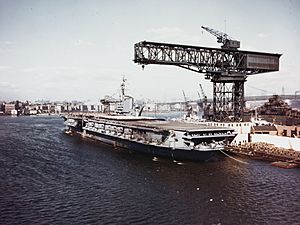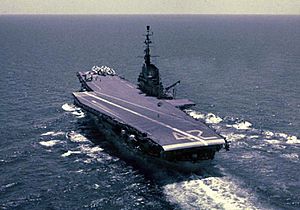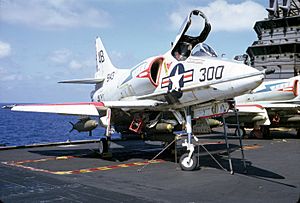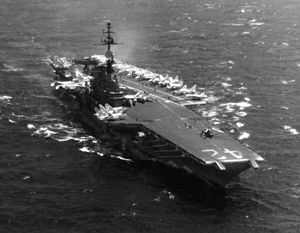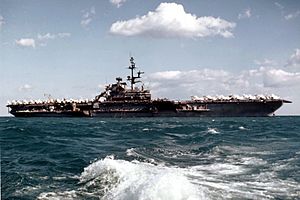USS Franklin D. Roosevelt facts for kids
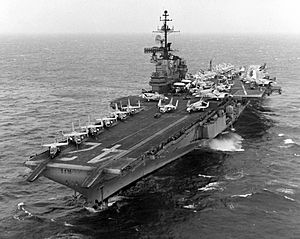
USS Franklin D. Roosevelt in 1971
|
|
Quick facts for kids History |
|
|---|---|
| Name | Franklin D. Roosevelt |
| Namesake | Franklin D. Roosevelt |
| Builder | New York Naval Shipyard |
| Laid down | 1 December 1943 |
| Launched | 29 April 1945 |
| Commissioned | 27 October 1945 |
| Decommissioned | 30 September 1977 |
| Stricken | 1 October 1977 |
| Nickname(s) |
|
| Fate | Scrapped, 3 May 1978 |
| Badge | 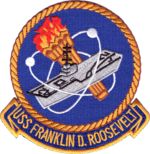 |
| General characteristics (as built) | |
| Class and type | Midway-class aircraft carrier |
| Displacement | 45,000 tons |
| Length | 968 ft (295 m) |
| Beam | 113 ft (34 m) |
| Draft | 35 ft (11 m) |
| Speed | 33 kn (61 km/h; 38 mph) |
| Complement | 4,104 officers and men |
| Armament |
|
| Aircraft carried | 137 |
The USS Franklin D. Roosevelt (CVB/CVA/CV-42) was a huge aircraft carrier. It was the second of three ships in the Midway class. Her crew had several fun nicknames for her, like "Swanky Franky" and "Foo-De-Roo." But "Rosie" was probably the most popular.
Roosevelt spent most of her time sailing in the Mediterranean Sea. She was an important part of the United States Sixth Fleet. The ship was taken out of service in 1977 and was later taken apart for scrap metal. She was special because she was the first U.S. Navy aircraft carrier named after a president. That president was Franklin D. Roosevelt.
Contents
Building and Early Missions
The Franklin D. Roosevelt began being built on December 1, 1943. This happened at the New York Naval Shipyard. She was first named Coral Sea when she was launched on April 29, 1945. But on May 8, 1945, President Harry S. Truman decided to rename her. She was renamed Franklin D. Roosevelt to honor the president who had just passed away.
Roosevelt officially joined the Navy on October 27, 1945. Her first captain was Apollo Soucek. She sailed to Rio de Janeiro, Brazil, in February 1946. There, she represented the U.S. at a presidential inauguration. In April and May, she took part in the Navy's first big training exercise after World War II.
On July 21, 1946, Roosevelt made history. She became the first American carrier to launch and land an all-jet aircraft. This was the McDonnell XFD-1 Phantom. Later, in November, a Lockheed P-80A jet also made successful take-offs and landings.
After more training, Roosevelt went on her first trip to the Mediterranean Sea. This was from August to October 1946. She visited Piraeus, Greece, to show U.S. support for the Greek government. This was during a civil war there. Thousands of people visited the ship in different ports. This trip started a long tradition. Roosevelt would make 20 more trips to the Mediterranean. This helped create the United States Sixth Fleet.
In July 1947, a storm damaged her front part. She had to go to Norfolk Naval Shipyard for repairs. From September 1948 to January 1949, she returned to the Mediterranean. In 1950, Roosevelt was the first carrier to carry nuclear weapons at sea. In 1952, she joined Operation Mainbrace. This was a big NATO exercise in the North Atlantic.
On October 1, 1952, Roosevelt was reclassified as CVA-42. In January 1954, she sailed to Puget Sound Naval Shipyard for a major upgrade. She was too big for the Panama Canal. So, she had to sail all the way around Cape Horn at the tip of South America. She arrived in March 1954 and was temporarily taken out of service for her refit.
Major Upgrades
The Franklin D. Roosevelt was the first ship of her class to get a huge upgrade. This project cost $48 million. She received a new, enclosed front part called a "hurricane bow." She also got new steam catapults to launch planes faster. Her landing system was improved, and her bridge (the command center) was made bigger. A special angled flight deck was added. This allowed planes to land even if other planes were parked on the deck.
Her radar systems were updated. The back elevator was moved, and the front one was made bigger. All elevators could now lift up to 75,000 pounds. The ship could also carry more aviation fuel. To make up for the extra weight, some of her guns were removed. Also, her thick armor belt, which weighed 3,200 tons, was taken off. She was put back into service on April 6, 1956.
After the upgrades, Roosevelt moved to her new home in Mayport, Florida. In February 1957, she tested her catapults and aircraft in cold weather. In July, she began the first of three trips with the United States Sixth Fleet. These trips included NATO exercises. Many important guests visited the ship each year.
In 1958, the remaining 3-inch guns were removed. On October 24, 1958, Franklin D. Roosevelt helped evacuate American citizens from Cuba. This happened during the Cuban Revolution.
In 1960, she received the first Fresnel Lens Optical Landing System (FLOLS). This system helps pilots land safely. In March 1961, she reached a milestone: her 100,000th aircraft landing. During a 1963 overhaul, six more 5-inch guns were removed.
In 1964, while in the Mediterranean, Franklin D. Roosevelt lost a part of one of her huge propellers. She had to sail back to New York for repairs.
From August 1966 to January 1967, Franklin D. Roosevelt went on her only trip to Southeast Asia. She spent 95 days helping in the Vietnam War. Her planes were mainly F-4 Phantom IIs and A-4 Skyhawks. Roosevelt earned one battle star for her service in Vietnam.
In January 1968, a famous Italian actress, Virna Lisi, visited the ship. She helped the crew celebrate the ship's 22nd birthday. They cooked 5,000 steaks on the flight deck!
Later Years and Retirement
Roosevelt was supposed to get another big upgrade. But a similar upgrade on another carrier cost too much money. So, Roosevelt received a smaller, less expensive upgrade. This $46 million project allowed her to operate newer planes. These included the A-6 Intruder and A-7 Corsair II.
In July 1968, Roosevelt went into the Norfolk Naval Shipyard for this 11-month upgrade. The front middle elevator was moved to the side. One of the catapults was removed. The crew's living areas were improved. All four remaining 5-inch anti-aircraft guns were taken off. She also got a new fire-fighting system. She returned to sea on May 26, 1969.
From August 1969, Carrier Air Wing Six became the ship's main air wing for the next seven trips. In January 1970, Roosevelt returned to the Mediterranean.
In October 1973, Roosevelt helped during the Yom Kippur War. She served as a "landing field" for planes being sent to Israel. Her group of ships was also ready to help with any evacuations.
In June 1976, Roosevelt carried 14 AV-8A Harrier attack aircraft. These planes can take off and land vertically, like a helicopter.
For her last mission, from October 1976 to April 1977, Roosevelt carried Carrier Air Wing Nineteen. The Harrier jets were on board for this trip. This showed that vertical take-off planes could work with regular planes on a carrier. However, the hot exhaust from the Harriers damaged the flight deck. On January 12, 1977, Roosevelt bumped into a Liberian cargo ship. This happened while sailing through the Strait of Messina. Both ships were able to continue to port.
End of Service
By the late 1970s, Roosevelt was getting old and worn out. She had not received all the big upgrades that other carriers had. This made her less modern and less capable. Also, her engines had ongoing problems. So, the Navy decided to take Roosevelt out of service. This happened when a newer carrier, the USS Dwight D. Eisenhower, joined the fleet in 1977.
Roosevelt finished her last trip in April 1977. She was officially taken out of service on September 30, 1977. There were efforts to turn her into a museum ship in New York City. But these plans did not work out.
Because of her poor condition, Roosevelt was not kept in the reserve fleet. Her hangar deck was also too low for some modern aircraft. On April 1, 1978, the ship was sold for $2.1 million. After useful parts were removed, the carrier was towed to Kearny, New Jersey. She arrived on May 3, 1978, and was taken apart for scrap metal that year. One of her big guns is now on display at White Sands Missile Range.
Awards and Honors
The USS Franklin D. Roosevelt earned many awards during her service. These include the Meritorious Unit Commendation and the Navy Expeditionary Medal. She also received the National Defense Service Medal and the Vietnam Service Medal.
Gallery
- USS ''Franklin D. Roosevelt'' lifecycle
-
A Buccaneer of 809 NAS from HMS Ark Royal aboard Roosevelt during her 1972 Mediterranean cruise.
See also
 In Spanish: USS Franklin D. Roosevelt (CV-42) para niños
In Spanish: USS Franklin D. Roosevelt (CV-42) para niños
- List of aircraft carriers
- List of aircraft carriers of the United States Navy


